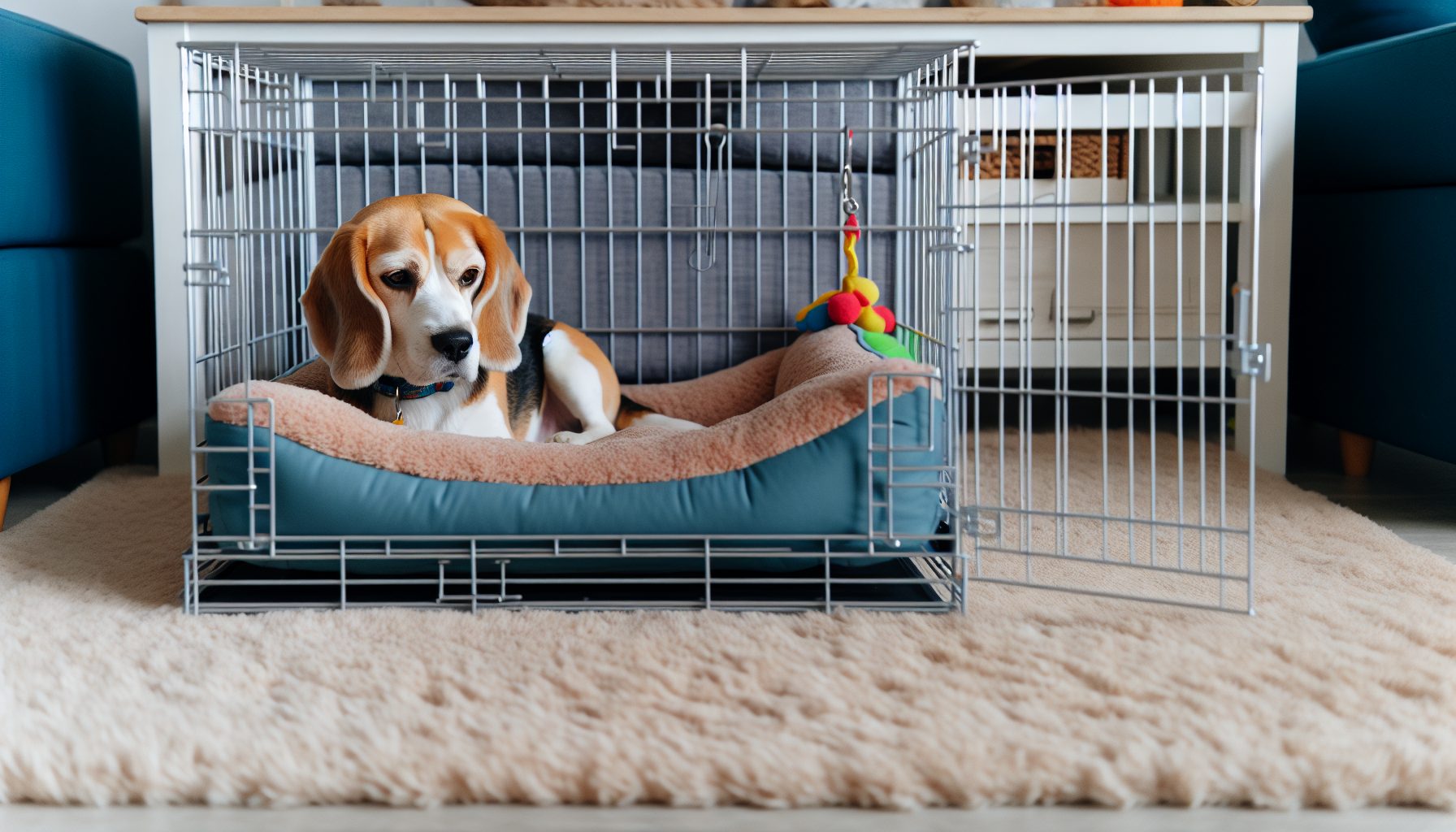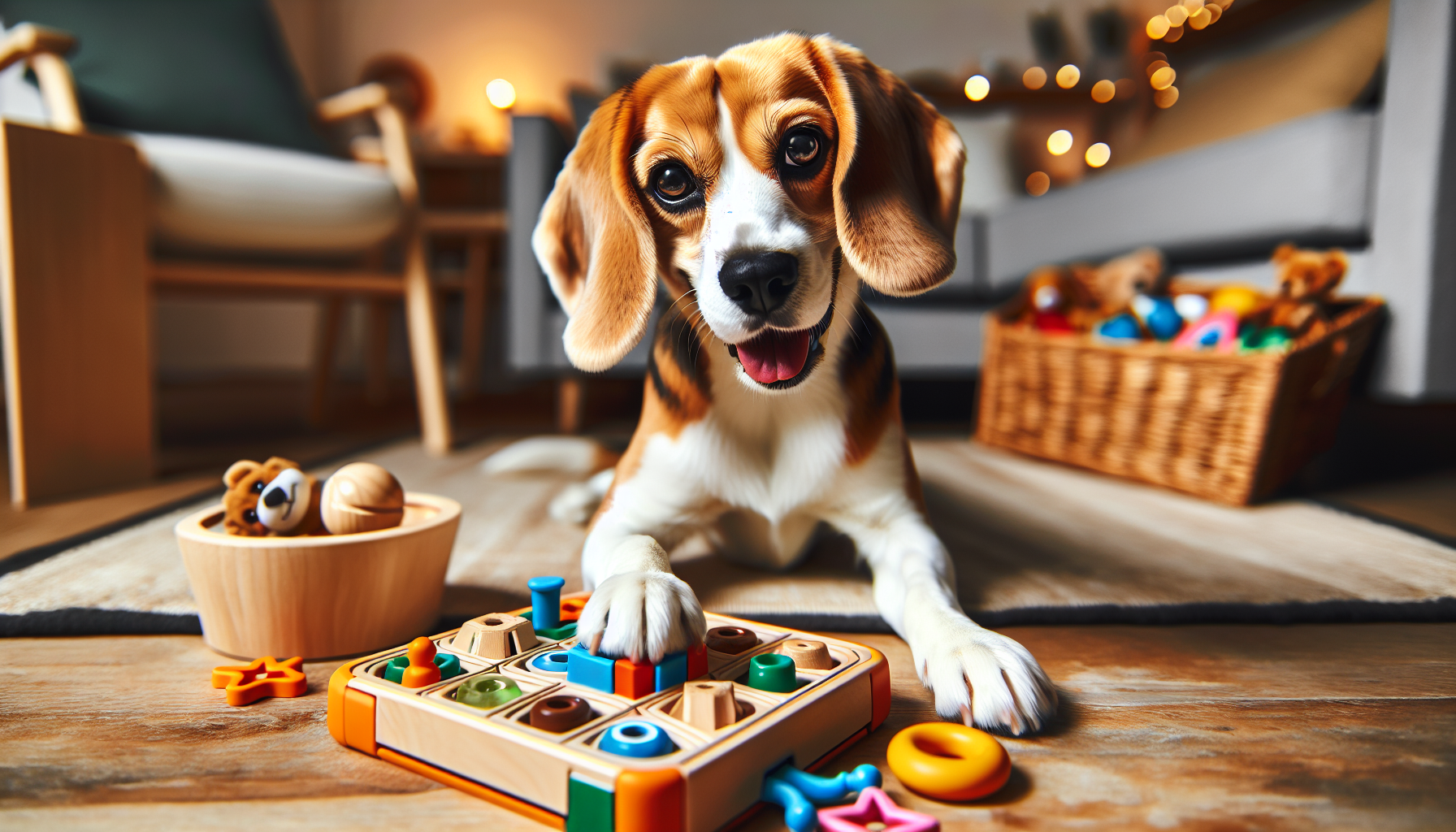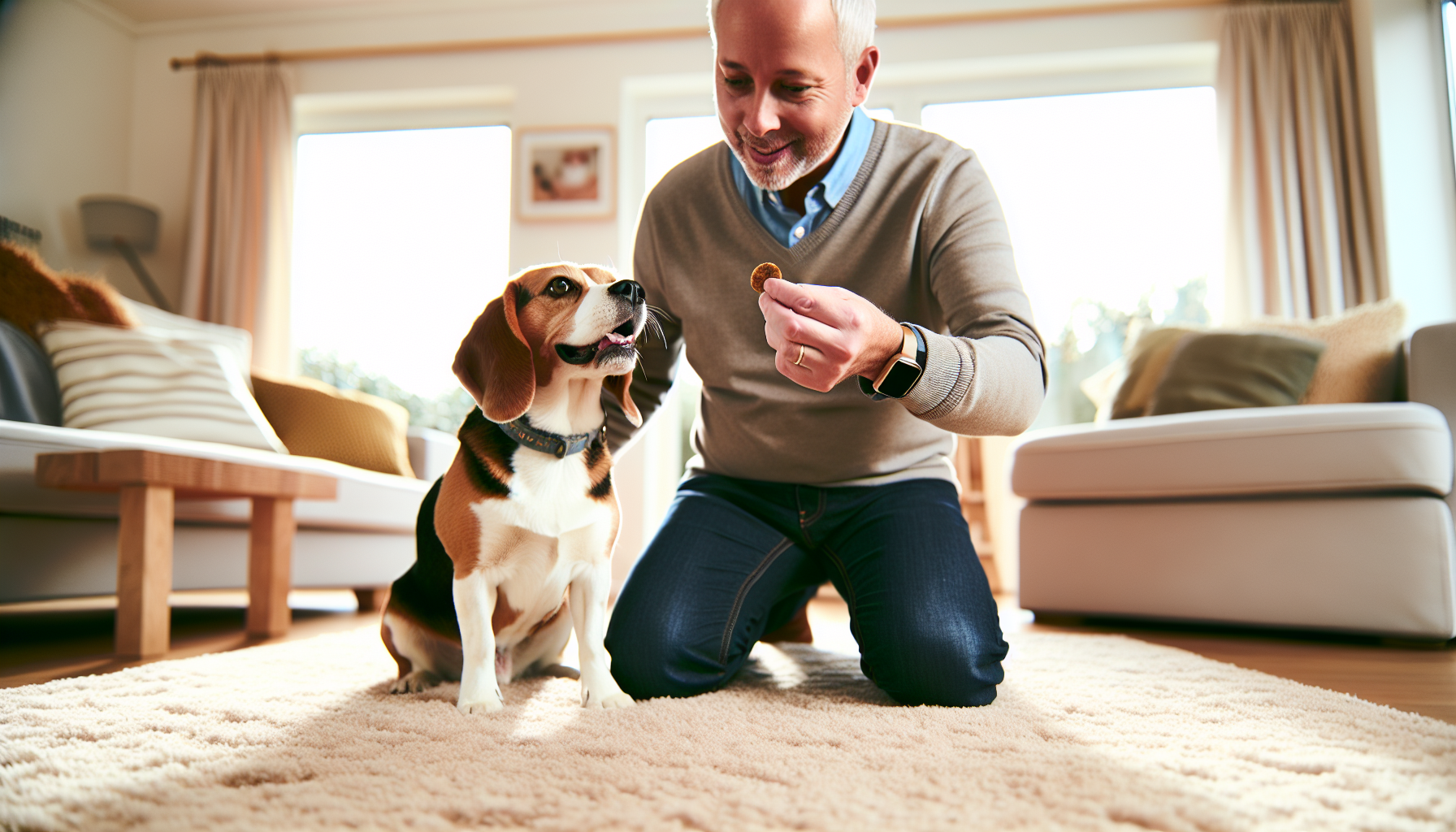Many beagle owners and potential beagle owners ask, can beagles be left alone? Well… let's Meet Bailey, a beagle whose day alone turns into a charming adventure. After his family leaves, she embarks on a treasure hunt for hidden treats, enjoys her favorite chew toy, and then cozies up in her crate for a nap. This isn't just a daydream; it's Bailey's reality and it can be for your beagle too!
With the right setup and some clever strategies, leaving your beagle alone can become an exciting and peaceful experience. Read on to discover how to make your beagle comfortable and safe enjoying its solo time.
Key Takeaways
- Due to their sociable nature, Beagles are susceptible to separation anxiety and should ideally not be left alone for more than four hours at a time. Without the right preparation, they may experience distress and exhibit destructive behaviors.
- To help your Beagle manage alone time, proper training is essential. This includes crate training, setting a consistent routine, and providing plenty of physical exercise and mental stimulation. These steps are crucial in maintaining your Beagle's well-being when they're on their own.
-
For extended absences, consider enlisting professional help such as dog walkers, doggy daycare, or pet sitters. These services can offer your Beagle necessary companionship and care, ensuring they are happy and healthy even when you can't be there.
Find out how to train your beagle to be the well-behaved pup you desire – Read Free Report
Understanding Beagle Independence

Image created using AI
Beagles are renowned for their sociability, which can be both a benefit and a challenge. Their friendly and outgoing nature makes them excellent companions, but it also predisposes them to separation anxiety due to their deep bond with their human families. As pack animals, they thrive in the company of others—both humans and animals—and can become deeply attached to their owners.
Here are some key points about the social nature of Beagles:
- Friendly and Outgoing: Beagles are known for their affable dispositions, enjoying interaction with people and other animals.
- Prone to Separation Anxiety: Their strong bonds can lead to anxiety when left alone, manifesting as distress or destructive behavior.
- Strong Bonds with Owners: Their pack animal instincts drive them to form close connections with their caregivers.
Addressing a Beagle's social needs is crucial for their emotional well-being. Proper training and care can teach them to handle solitude more effectively. Understanding their temperament and preparing them for times when they must be alone are essential to prevent anxiety. Without appropriate preparation, extended periods of solitude can exacerbate separation anxiety, leading to potential behavioral issues such as destructiveness or depression.
Managing these traits involves a blend of routine, training, and sometimes professional assistance like doggy daycare, which provides social interaction and activity to mitigate the effects of separation anxiety.
The Pack Animal Predicament
Beagles thrive on companionship, both with humans and other dogs. As pack animals, they instinctively understand social hierarchies and group dynamics, contributing to their reputation as friendly and sociable dogs. This pack mentality means they generally integrate well with other dogs and enjoy engaging interactions.
However, this same pack instinct can lead to challenges when Beagles are isolated. They relish the presence of others and may suffer from loneliness and anxiety when left alone. This propensity can manifest as separation anxiety if they lack adequate mental and physical stimulation during periods of solitude. Recognizing their need for social interaction and ensuring they receive sufficient engagement is key to managing their well-being.
Separation Anxiety in Beagles
Beagles, similar to their fellow scent hounds like basset hound, form unusually strong bonds with their owners and other family members, often more so than other dog breeds. When they’re left alone for a while, they can get really anxious and upset. Signs of separation anxiety in beagles include excessive barking, engaging in destructive chewing, or having accidents.
However, rest assured, separation anxiety is not insurmountable. Beagle owners can help their lonely dog by using strategies like crate training, gradually increasing alone time, and providing calming aids like pheromone sprays and anxiety vests to tackle separation anxiety beagles may experience.
Beagles should not be left alone for long periods, more than four hours at a time, to avoid increasing the risk of separation anxiety.
Beagle Temperament and Solo Time
Beagles, known for their varied temperaments, can be trained to manage alone time effectively. Reward-based training, such as giving treats or praise for entering their crate voluntarily or staying calm when left alone, can gradually teach Beagles to cope with solitude. However, this training requires patience and consistency from the owner.
For Beagles, it's best to start training for solitude at a young age. However, if you've adopted an older Beagle who isn't accustomed to being alone, it's crucial to start from scratch. Begin by leaving them alone in a secure space for short periods and slowly extend the duration as they become more comfortable.
Adult Beagles are generally capable of being left alone for about 4 to 6 hours. If they need to be alone for longer periods during the day, arranging for someone to provide a midday break for outdoor time can help manage their comfort and reduce anxiety. This balance of training and care ensures that Beagles can handle periods of solitude without undue stress.
Preparing Your Beagle for Alone Time

Image created using AI
Training your Beagle to handle alone time effectively can be straightforward when approached correctly. Key elements include crate training, establishing a consistent daily routine, and ensuring they get plenty of exercise and mental stimulation. A stable routine helps to minimize stress and anxiety, potentially preventing behavioral issues, and instills a sense of predictability for your Beagle.
Regular exercise is crucial for preparing your Beagle for times of solitude. A well-exercised Beagle is generally happier and more relaxed. Ensuring your Beagle is physically tired out can significantly mitigate issues of boredom and restlessness. Alongside physical activity, providing a variety of toys, puzzles, and chew treats can keep your Beagle engaged and entertained, further reducing the likelihood of destructive behaviors during alone time. This combination of physical and mental stimulation will help your Beagle feel more comfortable and content when left alone.
Crate Training Essentials
Crate training is a crucial step in teaching Beagle to stay calm and secure when left alone. To start, select a crate that allows your Beagle enough room to stand, turn around, and lie down comfortably. For an adult Beagle, a 36-inch crate typically provides ample space.
Introduce your Beagle to the crate gradually to build a positive association:
- Start Without Closing the Door: Let your Beagle explore the crate at their own pace without shutting the door, so they don't feel trapped or anxious.
- Create a Positive Environment: Place comfortable bedding, favorite toys, and even treats inside the crate to make it a pleasant and inviting space for your Beagle.
- Encourage Voluntary Entry: Use treats and gentle encouragement to invite your Beagle into the crate. The goal is for them to enter willingly and view the crate as a safe and rewarding place.
It’s important to remember that the crate should serve as a safe haven, not a punishment. Ensure that your Beagle does not spend more than six hours at a time in the crate without a break to stretch, play, and relieve themselves. This approach helps maintain their physical health and emotional well-being while preventing any negative associations with the crate.
By following these guidelines, you can help your Beagle feel more secure during alone time, contributing to a happier and more relaxed pet.
Establishing Routine and Consistency
Establishing a consistent routine is essential for helping your beagle adapt to being alone and reducing stress associated with solitude. By creating a predictable schedule of activities, including regular times for walks, meals, and play, beagles can feel more secure. Starting the day with exercise, followed by breakfast and a training session, and incorporating mentally stimulating activities in the afternoon, helps maintain a sense of normalcy and comfort for your beagle. Consistent adherence to this routine fosters a calmer, happier pet, making alone time more manageable for them.
Exercise and Mental Stimulation

Image created using AI
As a high-energy breed, Beagles need consistent physical activities to ensure their happiness and health. This doesn’t just mean physical activities like hiking, playing with a flirt pole, or going to dog parks. Mental stimulation is just as important to prevent boredom and destructive behaviors when Beagles are left alone.
In addition to physical exercise, mental stimulation can be achieved through various interactive toys and activities. Some examples include:
- Puzzle Toys: These challenge your Beagle's problem-solving skills and keep their mind active. Try this interactive puzzle toy on Amazon.
- Chew Treats: Suitable for prolonged engagement, they help reduce stress and keep your Beagle occupied. Try the Benebone Wishbone right here.
- Hide and Seek: Playing games that involve hiding objects or even yourself can provide both mental and physical stimulation.
- Finding Hidden Treats: Setting up a hunt for treats around your home can engage your Beagle's natural sniffing instincts.
These activities do more than just entertain; they help alleviate anxiety and foster a feeling of connection and engagement for your Beagle. Regular incorporation of these stimulating tasks is crucial for their overall well-being.
Mitigating Negative Behaviors in Solitary Beagles
Addressing common issues such as excessive barking, destructive chewing, and accidents is crucial when your beagle spends time alone. These behaviors often stem from boredom, anxiety, or loneliness, but with the right strategies, they can be mitigated effectively.
Addressing Excessive Barking

Image created using AI
Excessive barking can disrupt your household and stress your beagle. This behavior may arise from disturbances, boredom, or anxiety. Implementing strategies such as positive reinforcement can help reduce barking:
- Reward quiet behavior with treats and praise.
- Provide engaging toys or activities to divert their attention.
- Use soothing background music or white noise to help calm your beagle.
Preventing Destructive Chewing
Destructive chewing is another challenge that arises from anxiety or boredom. To prevent this:
- Offer a variety of chew toys, such as Nylabones, edible chews, and durable rubber toys, to keep your beagle occupied.
- Puppy-proof your home and apply dog repellent sprays on valuable items to deter chewing.
- Engage your beagle in mental and physical activities to mitigate their anxiety and boredom.
Coping with Accidents
Accidents are more common in puppies but can occur in adult beagles left alone for extended periods. Here’s how to manage them:
- Ensure regular potty breaks, especially for puppies who may need to go outside every hour.
- Establish a consistent routine for going outside.
- Teach and use a specific potty command to help them understand where and when to relieve themselves.
- For indoor training, consider tethering your beagle to you with a leash to monitor and prevent potential accidents.
By understanding the root causes of these behaviors and consistently applying these strategies, you can help your beagle adjust to spending time alone, ensuring they remain happy and well-behaved even in your absence.
Professional Assistance for Your Beagle Puppies
Sometimes, life’s demands mean we have to leave our furry friends alone for longer than we would prefer. In these instances, enlisting the help of professional services like dog walkers, doggy daycare, and pet sitters can be invaluable.
These professional options do more than just meet your beagle's physical needs—they also support their emotional health. Access to regular socialization, adequate exercise, and mental stimulation through these services can significantly improve your beagle’s overall quality of life, helping to keep them happy, active, and engaged even when you can't be there.
The Role of a Dog Walker
Hiring a dog walker can greatly benefit your beagle, particularly if your work schedule limits the time you can dedicate to their exercise needs. Regular walks are crucial for your beagle's health, offering both physical exercise and mental stimulation.
When selecting a dog walker, it's important to consider their qualifications and experience with dogs, especially with active breeds like beagles. Ideally, your beagle should be walked at least once daily, though twice is preferable for optimal health. Each walk should be moderately brisk and last at least 40 minutes to provide sufficient exercise and stimulation.
Ensuring your dog walker is a good match for your beagle not only helps maintain your dog's physical fitness but also enhances their day-to-day happiness by breaking up long hours alone and providing essential companionship.
Benefits of Doggy Daycare
Doggy daycare offers a dynamic and engaging environment for Beagles, providing them with the opportunity to socialize, play, and receive ample attention from staff. This environment can significantly reduce their anxiety when separated from their owners by fulfilling their inherent need for social interaction.
Moreover, doggy daycare can be instrumental in improving a Beagle's social behaviors. Regular interaction with a variety of dogs allows Beagles to learn appropriate social cues and understand other dogs' body language better. This exposure can decrease behavioral problems and enhance their ability to communicate effectively with their canine peers.
For Beagles that are naturally social and enjoy the company of other dogs, doggy daycare can be particularly beneficial. It offers a safe and supervised setting for them to engage with other dogs, which is not only enjoyable but also critical for their overall development and well-being.
Selecting a Pet Sitter
Selecting a pet sitter who can provide care in the familiar environment of your home offers a more personalized approach and can be particularly comforting for your beagle. To ensure the best care for your pet, it’s important to consider several factors when choosing a pet sitter:
- Licensing and Insurance: Ensure the pet sitter is licensed, insured, and bonded. This protects both your pet and your property in case of accidents or incidents.
- Experience with Beagles: Look for a pet sitter with specific experience handling Beagles, as they will be familiar with the breed's traits and needs.
- Introduction: Arrange a meeting between your beagle and the sitter beforehand. This helps ensure that your dog feels comfortable with the sitter, facilitating a smoother experience while you're away.
Taking these steps will help you find a reliable and competent sitter, providing peace of mind that your beagle is in good hands during your absence.
Lifestyle Adjustments for Beagle Owners
Being a Beagle owner necessitates certain lifestyle modifications to safeguard their well-being, especially when you have a beagle puppy. This includes setting up a regular schedule for your Beagle that includes exercise, feeding, and playtime. Also, don’t forget to set reminders for all the pet care tasks.
You can totally get your beagle involved in social activities by:
- Joining puppy play groups
- Visiting dog parks
- Participating in obedience classes
- Inviting friends over to meet your Beagle
It’s a great way to keep your pup mentally stimulated and strengthen your bond with them.
Work-Life Balance for Pet Owners
Maintaining a balance between work responsibilities and pet ownership is key for the well-being of a beagle. For those who cannot work from home, establishing a reliable routine is essential. It's important to ensure your beagle has a comfortable space of their own and to employ positive training methods, such as crate training, to foster a safe and secure environment. Providing engaging toys and activities can help keep them occupied and content.
Even with a busy work schedule, taking the time for quick play sessions with your beagle can offer a much-needed break for both you and your pet. These moments are an opportunity to strengthen your bond and bring a joyful pause to your day, enhancing both your lives with a touch of lightheartedness and fun.
Integrating Beagles into Social Activities
Involving beagles, known as intelligent dogs, in communal activities significantly boosts their mental engagement and offers supplemental companionship. Taking them to social events, introducing them to other friendly dogs, and keeping up with scent work activities can make their alone time more enjoyable.
Regularly exposing them to new adult dogs, like most dogs, in a controlled setting can make introducing your Beagle to new people less stressful.
Summary
In this discussion, we've explored how to effectively manage the alone time of Beagles, focusing on their need for companionship and ways to mitigate separation anxiety. We've emphasized the importance of crate training, setting consistent routines, and keeping them both physically and mentally stimulated. For longer periods of absence, the use of professional services such as dog walkers and pet sitters is advisable. As caretakers of Beagles, it is our responsibility to implement these practices to ensure the happiness and well-being of our beloved pets, ensuring they feel secure and loved, even in our absence.
Frequently Asked Questions
Can beagles be left alone while at work?
Yes, beagles can be left alone while you're at work, but it's important to plan and prepare to ensure their well-being and prevent separation anxiety.
How long can I leave Beagle alone?
You can leave your Beagle alone for a few hours. By now, your Beagle should be comfortable spending time on her own in a safe place.
What dog can be left alone for 8 hours?
The Basset Hound, French Bulldog, Chihuahua, and Pugs are some dog breeds that can be left alone for 8 hours once they can handle 4 hours alone.
Are beagles difficult dogs to own?
Beagles can be a good fit for active families, but their strong hunting instinct requires rigorous training, which may not be ideal for first-time owners. However, their sociable and mischievous nature can make them enjoyable to own.
What are some common negative behaviors in solitary beagles?
Solitary beagles may exhibit behaviors like excessive barking, destructive chewing, and accidents. It's important to address these behaviors with appropriate training and enrichment.
Learn how to train your beagle to be the well-behaved dog you desire –> Access our Free Report
Shop for beagle-themed products and gifts that beagle enthusiasts will love.

